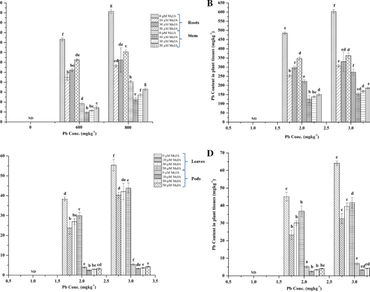Effect of methyl jasmonate in enhanced growth, antioxidants and reduced Pb uptake in contrasting cluster bean cultivars
Research Articles | Published: 02 October, 2022
First Page: 127
Last Page: 132
Views: 3027
Keywords: Lead, Methyl jasmonate, Cluster bean, Antioxidant enzymes, Pb accumulation
Abstract
Lead is known as the second toxic heavy metal which negatively affects plant growth. Hence, there is a need to develop eco-friendly techniques to overcome the negative impacts of Pb on plants. Plant hormones play an essential role in amelioration of heavy metal toxicity. In the current study, the effects of exogenous application of methyl jasmonate (0, 10, 30 and 50 µM) on growth, antioxidant enzymes and Pb uptake of two contrasting cultivars of cluster bean (RGC 1055 and RGC 1066) were evaluated under various lead-treatments (0, 600, 800 mg/kg). In RGC 1066, the Pb uptake in roots, shoot, leaves, and pods decreased by 49.28%, 43.73%, 32.78% and 29.06%, respectively by the exogenous application of MeJA (10µM) under Pb stress (800 mg/kg). The current findings concluded that MeJA enhanced the detrimental effect of lead by increasing growth, activity of antioxidant enzymes and reducing Pb accumulation in both cultivars. Hence, application of MeJA can be considered as an efficient method in minimizing toxic effects of lead by reducing lead uptake in cluster bean cultivars growing in contaminated soil.

References
Aebi H (1984) Catalase in vitro. Methods Enzymol 105:121–126
Ahmad P, Alyemeni MN, Wijaya L, Alam P, Ahanger MA, Alamri SA (2017) Jasmonic acid alleviates negative impacts of cadmium stress by modifying osmolytes and antioxidants in faba bean (Vicia faba L.). Arch Agron Soil Sci 63:1889–1899
Ali E, Hussain N, Shamsi IH, Jabeen Z, Siddiqui MH, Jiang LX (2018) Role of jasmonic acid in improving tolerance of rapeseed (Brassica napus L.) to Cd toxicity. J Zhejiang Univ Sci B 19:130
Amin H, Arain BA, Abbasi MS, Jahangir TM, Amin F (2018) Comparative study of Zn-phytoextraction potential in guar (Cyamopsis tetragonoloba L.) and sesame (Sesamum indicum L.): tolerance and accumulation. Geol Ecol Landsc 2:29–38
Bali S, Kaur P, Kohli SK, Ohri P, Thukral AK, Bhardwaj R, Wijaya L, Alyemeni MN, Ahmad P (2018) Jasmonic acid induced changes in physio-biochemical attributes and ascorbate–glutathione pathway in Lycopersicon esculentum under lead stress at different growth stages. Sci Total Environ 645:1344–1360
Barata RM, Chapparro A, Chabregas SM, Gonzalez R, Labate CA, Azevedo RA, Sarath G, Lea PJ, Silva-Filho MC (2000) Targeting of the soybean leghemoglobin to tobacco chloroplasts: effects on aerobic metabolism in transgenic plants. Plant Sci 155:193–202
Beauchamp C, Fridovich I (1971) Superoxide dismutase: improved assays and an assay applicable to acrylamide gels. Anal Biochem 44:276–287
Chen J, Yan Z, Li X (2014) Effect of methyl jasmonate on cadmium uptake and antioxidative capacity in Kandelia obovata seedlings under cadmium stress. Ecotoxicol Environ Saf 104:349–356
De Vos CHR, Schat H, De Waal MAM, Vooijs R, Ernst WHO (1991) Increased to copper-induced damage of the root plasma membrane in copper tolerant Silene cucubalus. Physiol Plant 82:523–528
Farooq MA, Gill RA, Islam F, Ali B, Liu H, Xu J, He S, Zhou W (2016) Methyl jasmonate regulates antioxidant defense and suppresses arsenic uptake in Brassica napus L. Front Plant Sci 7:468
Fatma M, Iqbal N, Sehar Z, Alyemeni MN, Kaushik P, Khan NA, Ahmad P (2021) Methyl jasmonate protects the ps ii system by maintaining the stability of chloroplast D1 protein and accelerating enzymatic antioxidants in heat-stressed wheat plants. Antioxidants 10(8):1216
Foyer CH, Noctor G (2011) Ascorbate and glutathione: the heart of the redox hub. Plant Physiol 155:2–18
Hadi F, Aziz T (2015) A mini review on lead (Pb) toxicity in plants. J Biol Life Sci 6:91–101
Hanaka A, Wójcik M, Dresler S, Mroczek-Zdyrska M, Maksymiec W (2016) Does methyl jasmonate modify the oxidative stress response in Phaseolus coccineus treated with Cu. Ecotoxicol Environ Saf 124:480–488
Hashem HA, El-Sherif NA (2019) Exogenous jasmonic acid induces lead stress tolerance in kidney bean (Phaseolus vulgaris L.) by changing amino acid profile and stimulating antioxidant defense system. Jordan J Biol Sci 12:345–353
Jayakumar K (2019) Antioxidant enzyme mechanism of cluster bean (Cyamopsis tetragonaloba (L.) Taub). under cobalt stress. World News Nat Sci 24:64–70
Kamran M, Wang D, Alhaithloul HAS, Alghanem SM, Aftab T, Xie K, Lu Y, Shi C, Sun J, Gu W, Xu P (2021) Jasmonic acid-mediated enhanced regulation of oxidative, glyoxalase defense system and reduced chromium uptake contributes to alleviation of chromium (VI) toxicity in choysum (Brassica parachinensis L.). Ecotoxicol Environ Saf 208:111758
Kaur G, Singh HP, Batish DR, Kohli RK (2013) Lead (Pb)-induced biochemical and ultrastructural changes in wheat (Triticum aestivum) roots. Protoplasma 250:53–62
Mousavi SR, Niknejad Y, Fallah H, Tari DB (2020) Methyl jasmonate alleviates arsenic toxicity in rice. Plant Cell Rep 39:1041–1060
Nakano Y, Asada K (1981) Hydrogen peroxide is scavenged by ascorbate-specific peroxidase in spinach chloroplasts. Plant Cell Physiol 22:867–880
Piotrowska A, Bajguz A, Godlewska-Żyłkiewicz B, Czerpak R, Kamińska M (2009) Jasmonic acid as modulator of lead toxicity in aquatic plant Wolffia arrhiza (Lemnaceae). Environ Exp Bot 66:507–513
Pourrut B, Shahid M, Dumat C, Winterton P, Pinelli E (2011) Lead uptake, toxicity, and detoxification in plants. Rev Environ Contam Toxicol 213:113–136
Putter J (1974) Peroxidases. methods of enzymatic analysis. Acad press 2:685–690
Sangwan P, Kumar V, Khatri RS, Joshi UN (2013) Chromium (VI) induced biochemical changes and gum content in cluster bean (Cyamopsis tetragonoloba L.) at different developmental stages. J Bot 2013:1–8
Author Information
Department of Bioscience and Biotechnology, Banasthali Vidyapith, Tonk, India